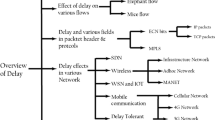Abstract
According to the QoS features of the four types of UMTS traffic, this study proposes a priority-based queuing scheme to support differentiated services among all UMTS traffic; it bases on packet transmission priorities of four types of UMTS traffic to handle packets forwarding in a gateway within a UMTS core network. In the proposed queuing scheme, a static dedicated logical queuing buffer allocation and a dynamic overflow buffer allocation are used to support packet enqueuing/dequeuing jobs. In this study, the ns2 network simulator is used as a simulation platform and different categories of simulation scenarios are executed. Moreover, the IETF DiffServ scheme is used as a comparison to understand the packet forwarding performance of the proposed scheme. By analyzing simulation data, two important points can be drawn. The proposed queuing scheme supports a differentiated packet forwarding behavior among four types of UMTS traffic. And, the differentiated packet forwarding behaviors with the proposed queuing scheme are similar to the packet forwarding behavior with the IETF DiffServ scheme.
Similar content being viewed by others
References
3G Tutorial, UMTS overview, http://www.umtsworld.com/technology/overview.htm.
Tham C.-K., Yao Q., Jiang Y. (2002) Achieving differentiated services through multi-class probabilistic priority scheduling. Computer Networks 40(4): 577–593
3GPP TR 23.922. (1999). Architecture for an All IP network.
3GPP TS 23.107. (2005). QoS Concept and Architecture. Release 6.
White, P. P. (1997). RSVP and integrated services in the internet: A tutorial. IEEE Commun. Mag., 100–106.
Dovrolis, C., & Ramanathan, P. (1999). A case for relative differentiated services and the proportional differentiation model. IEEE Network.
Mankin, A., et al. (1997). RSVP version 1: Applicability statement, some guidelines on deployment. IETF RFC 2208.
Nichols, K., et al. (1998). Definition of the differentiated services field (DS Field) in the IPv4 and IPv6 headers. IETF RFC 2474.
Blake, S. et al. (1998). An architecture for differentiated services. IETF RFC 2475.
Mahajan, M., Ramanathan, A., & Parashar, M. Active resource management for the differentiated services environment.
Braden, B., Clark, D., Crowcroft, J., Davie, B., Estrin, D., Floyd, S., et al. (1998). Recommendation on queue management and congestion avoidance in the internet. IETF RFC 2309.
Aweya J., Ouellette M., Montuno D., Felske K. (2006) Rate-based proportional-integral control scheme for active queue management. International Journal of Network Management 16(3): 203–231 (John Wiley & Sons, Ltd)
Su, L., Zheng, R., & Hou, J. C. (2000). An active queue management scheme for Internet congestion control and its application to differentiated services. In Proceedings of ICCCN 2000, Las Vegas, NV, pp. 62–68.
Arpaci M., Copeland J. A. (2000) Buffer-management of shared-memory ATM switches. IEEE Communications, Surveys 3(1): 2–10
Latouch G. (1980) Exponential servers sharing a finite storage: Comparison of space allocation policies. IEEE Transactions on Communications COM-28(6): 910–915
Kamoun F., Kleinrock L. (1980) Analysis of shared finite storage in a computer network node environment under general traffic conditions. IEEE Transactions on Communications COM-28(7): 992–1003
Lymberopoulos, L., Lupu, E., & Sloman, M. (2002). An adaptive policy based management framework for differentiated services networks. In Proceedings of the 3rd IEEE workshop on policies for distributed systems and networks (Policy 2002) pp. 147–158. Monterey, CA.
ETSI TS 122 105. (2002). Services and service capabilities, V5.2.0, http://www.etsi.org.
3GPP TR 23.922. (1999). Architecture for an All IP network.
3G TS 122.105. (1999). Services and service capabilities, version 3.6.03.6.0.
Kaaranen H., Ahtiainen A., Laitinen L., Naghian S. (2005) Valtteri niemi, UMTS networks: Architecture, mobility and services . (2nd ed.). Wiley, 111 River Street Hoboken, NJ
Floyd, S., & Jacobson V. (1993). Random early detection gateways for congestion avoidance. IEEE/ACM Transactions on Networking.
Matsuda T., Nagata A., Yamaoto M. (2005) Performance analysis and improvement of highSpeed TCP with TailDrop/RED routers. IEICE Transactions on Communications E88-B(6): 2495–2507
Ohsaki Hiroyuki, Murata Masayuki (2002) Steady state analysis of the RED gateway: Stability, transient behavior, and parameter setting. E85-B 1: 107–115
Floyd, S. (1997). RED: Discussions of setting parameters, available at http://www.icir.org/floyd/REDparameters.txt.
Matsufuru N., Nishimura K., Aibara R. (1999) Comparative evaluation of resource allocation strategies using weighted round robin scheduler in ATM switches. IEICE Transactions on Communications E82-B(1): 60–69
McCanne, S., & Floyd, S. (2004). ns Network simulator. Available as: http://www.isi.edu/nsnam/ns/.
Author information
Authors and Affiliations
Corresponding author
Rights and permissions
About this article
Cite this article
Fu, CH. A Study on Differentiated Service Queuing Scheme with an Overflow Buffer Allocation Within a UMTS Core Network. Wireless Pers Commun 55, 325–347 (2010). https://doi.org/10.1007/s11277-009-9804-2
Received:
Accepted:
Published:
Issue Date:
DOI: https://doi.org/10.1007/s11277-009-9804-2




